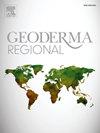Fertility status of Chernozems and Phaeozems under different moisture regimes in southwestern Poland
IF 3.3
2区 农林科学
Q2 SOIL SCIENCE
引用次数: 0
Abstract
Chernozems and Phaeozems, consider the most fertile soils in the world, are of particular interest in Poland due to their little contribution to soil cover, which does not exceed 1.5 %. The study focused on the characterization and regional and global comparison of SOC and fertility status of chernozemic soils in SW Poland to provide arguments for their further protection. The soils developed from loess were cross-analyzed in relation to their classification (Chernozems versus Phaeozems) and moisture status (well-drained versus imprefectly-drained soils). The soils have a silt loam texture and a greater thickness of humus horizon, pH, base saturation, content of SOC, nitrogen, and plant-available P, K and Mg than majority soils in Poland. The mean values were comparable or higher than in the other chernozemic regions in Poland and the world; only pH and SOC were lower than in Chernozems of the steppe zones. On a regional scale, Chernozems had a higher pH, base saturation, SOC, P and K concentrations and pools than Phaeozems. Whereas, the moisture status did not significantly differentiate the fertility of chernozemic soils, which confirms that long-term moisture control of historically waterlogged soils allowed for their cultivation with the same intensity as well-drained soils. Comparison with historical data suggested that SOC and nutrients increased or remained at a similar level over the 70 years. The study confirmed a high and stable SOC and fertility status of chernozemic soils in SW Poland, maintained rather than degraded by agricultural use. Considering an ongoing climate change, leading to increasing frequency of droughts in Central Europe, as well as rapid urbanization, resulting in destruction of native soils, the results argue for permanent monitoring and legal protection of Chernozems and Phaeozems as soils of great importance for national food security and SOC sequestration.
波兰西南部不同湿度条件下黑钙土和费厄泽土的肥力状况
chernozem和phaeozem被认为是世界上最肥沃的土壤,由于它们对土壤覆盖的贡献很小,不超过1.5%,因此在波兰特别受关注。本文通过对波兰西南部黑钙化土壤的特征、土壤有机碳和肥力状况的区域和全球比较,为进一步保护黑钙化土壤提供依据。对黄土发育的土壤进行了分类(黑钙土与非黑钙土)和水分状况(排水良好与不完全排水土壤)的交叉分析。土壤具有粉壤土质地,腐殖质层厚度、pH值、碱饱和度、有机碳、氮含量和植物有效磷、钾和镁含量比波兰大多数土壤都要高。平均值与波兰和世界其他黑钙化地区相当或更高;只有pH和SOC低于黑钙土的草原带。在区域尺度上,黑钙土的pH、碱饱和度、有机碳、磷、钾浓度和库均高于非黑钙土。土壤水分状况对黑钙化土壤的肥力影响不显著,说明长期水分控制可以使黑钙化土壤的种植强度与排水良好的土壤相同。与历史数据比较表明,土壤有机碳和养分在70 a内呈增加或保持不变的趋势。该研究证实了波兰西南部黑钙化土壤的高且稳定的有机碳和肥力状态,并没有因农业利用而退化。考虑到持续的气候变化导致中欧干旱频率的增加,以及快速的城市化导致原生土壤的破坏,研究结果主张对黑钙土和非黑钙土进行永久监测和法律保护,因为它们对国家粮食安全和有机碳封存具有重要意义。
本文章由计算机程序翻译,如有差异,请以英文原文为准。
求助全文
约1分钟内获得全文
求助全文
来源期刊

Geoderma Regional
Agricultural and Biological Sciences-Soil Science
CiteScore
6.10
自引率
7.30%
发文量
122
审稿时长
76 days
期刊介绍:
Global issues require studies and solutions on national and regional levels. Geoderma Regional focuses on studies that increase understanding and advance our scientific knowledge of soils in all regions of the world. The journal embraces every aspect of soil science and welcomes reviews of regional progress.
 求助内容:
求助内容: 应助结果提醒方式:
应助结果提醒方式:


